Logic Supply ML100G-50 Fanless Skylake vPro Industrial NUC Review
by Ganesh T S on February 27, 2017 8:00 AM ESTPerformance Metrics - I
The Logic Supply ML100G-50 was evaluated using our standard test suite for low power desktops / industrial PCs. Not all benchmarks were processed on all the machines due to updates in our testing procedures. Therefore, the list of PCs in each graph might not be the same. In the first section, we will be looking at SYSmark 2014 SE, as well as some of the Futuremark benchmarks.
BAPCo SYSmark 2014 SE
BAPCo's SYSmark 2014 SE is an application-based benchmark that uses real-world applications to replay usage patterns of business users in the areas of office productivity, media creation and data/financial analysis. In addition, it also addresses the responsiveness aspect which deals with user experience as related to application and file launches, multi-tasking etc. Scores are meant to be compared against a reference desktop (the SYSmark 2014 SE calibration system in the graphs below). While the SYSmark 2014 benchmark used a Haswell-based desktop configuration, the SYSmark 2014 SE makes the move to a Lenovo ThinkCenter M800 (Intel Core i3-6100, 4GB RAM and a 256GB SATA SSD). The calibration system scores 1000 in each of the scenarios. A score of, say, 2000, would imply that the system under test is twice as fast as the reference system. Since the Logic Supply ML100G-50 is one of the first passively cooled PCs to be subject to the SYSmark 2014 SE benchmark, we only have the reference system to compare against in this subsection.

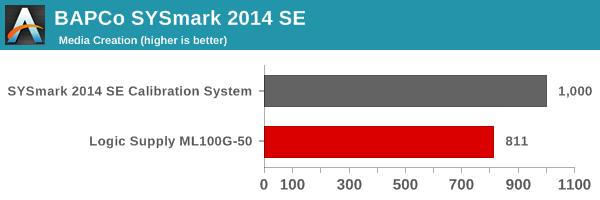

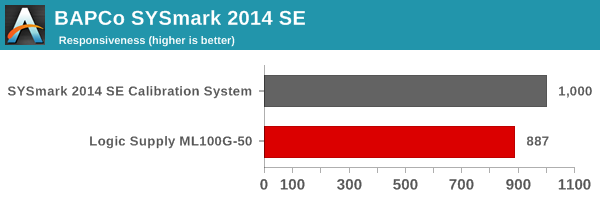

SYSmark 2014 SE also adds energy measurement to the mix. A high score in the SYSmark benchmarks might be nice to have, but, potential customers also need to determine the balance between power consumption and the efficiency of the system. For example, in the average office scenario, it might not be worth purchasing a noisy and power-hungry PC just because it ends up with a 2000 score in the SYSmark 2014 SE benchmarks. In order to provide a balanced perspective, SYSmark 2014 SE also allows vendors and decision makers to track the energy consumption during each workload. In the graphs below, we find the total energy consumed by the PC under test for a single iteration of each SYSmark 2014 SE workload and how it compares against the calibration systems.
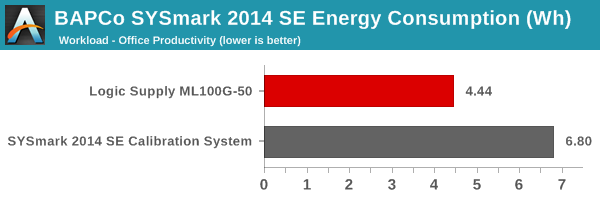


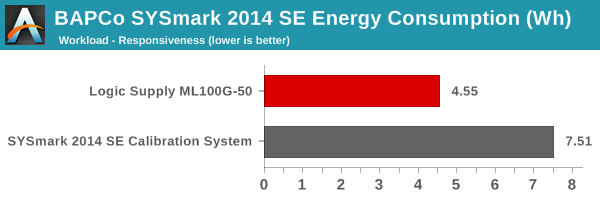
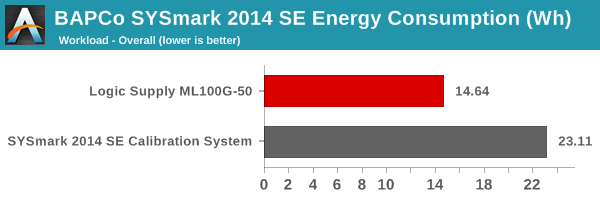
The U-series Core i5-6300U is not going to be competitive against a full-blown 65W TDP desktop processor, but, in terms of energy consumption, the ML100G-50 is a lot better compared to the reference desktop.
Futuremark PCMark 8
PCMark 8 provides various usage scenarios (home, creative and work) and offers ways to benchmark both baseline (CPU-only) as well as OpenCL accelerated (CPU + GPU) performance. We benchmarked select PCs for the OpenCL accelerated performance in all three usage scenarios. These scores are heavily influenced by the CPU in the system. The Core i5-6300U enables the ML100G-50 to come out on top in all of the Futuremark benchmarks when compared with fanless systems evaluated earlier using the same methodology. The closest competitor is the Zotac ZBOX CI523 nano based on a Core i3-6100U.



Miscellaneous Futuremark Benchmarks





The Intel HD Graphics 520 is also one of the most powerful GPUs we have seen in fanless computing systems in this form factor, as shown by the 3DMark benchmarks in the above graphs.
3D Rendering - CINEBENCH R15
We have moved on from R11.5 to R15 for 3D rendering evaluation. CINEBENCH R15 provides three benchmark modes - OpenGL, single threaded and multi-threaded. Evaluation of select PCs in all three modes provided us the following results.



In the single-threaded version, the ML100G-50 performs similar to the ML100G-30 despite the 100 MHz bump in the core clock. However, the multi-threaded version gives it a clear lead. In the OpenGL version, the Zotac ZBOX CI53 nano using the Core i3-6100U with the same graphics configuration (HD Graphics 520 operating at 300 MHz / 1 GHz) has a slight lead.










37 Comments
View All Comments
BrokenCrayons - Wednesday, March 1, 2017 - link
Most people have that extra space, but these systems aren't intended for desktop use. They're targeted at industrial environments where dust ingestion due to active cooling would contribute to the early demise of a conventional computer. Consumers rarely need this kind of hardware unless they're doing something like HAM radio or another chore that needs a passively cooled design.fanofanand - Wednesday, March 1, 2017 - link
Yeah I kind of gathered that after posting my comment, but I think my comment is still applicable beyond this one specific box. The SFF space is one of the last bastions of "premium pricing" outside of corporate and "gaming". I mean what we have here is a super low power CPU, with an IGP, and basic RAM selling for the price of an alienware laptop. It's just hard to wrap my head around. I get it for industrial applications but not for everyday consumers.milkod2001 - Thursday, March 2, 2017 - link
Market is big enough that even NUCs while they are useless and overpriced for what they offer still sell. Good thing is: you don't have to buy them, you can just completely ignore them and move on :)nowayandnohow - Thursday, March 2, 2017 - link
"you can just completely ignore them and move on"Exactly, stop whining and go to the market segment that targets what you need.
nowayandnohow - Thursday, March 2, 2017 - link
Look, I am a prime customer for this solution: I need a somewhat capable small server for a location - on this location I also need to run 2VM's which each uses their own NIC (I am looking at their Xeon equipped server with 6 x NIC, 32GB ECC RAM, and 4 drives in RAID6). All of this is going to be supporting a low maintenance, long periods of no-computers-and-very-little-web-traffic location. This is perfect.What sets this one apart is that it is small, really small, and it has ZERO moving parts. It will not have a fan failure, it will not have a spinning disk doing all the things spinning disks do. It'll be dead quiet, run what I need for it to run, hidden away in a closet, running 24/7.
Of course i could build my very own, for probably half the price and double the specs, but this is not what I am looking for. This is not intended for home tinkers, and the price comes with turnkey (with warranty) setup, and I am willing to pay for that.
We need to end this "it can be done cheaper", someone needs to make a buck on putting capable systems together, with purpose not only to support gamers that would never buy it in the first place, and uses components that are not the 'cheapest possible available'. Otherwise all computers will just be either super expensive for coorporations, or super low budget like half of the SFF units out there today. Who the hell wants an i3 with cheap-ass RAM, slow spinning HD and then the capacity to push out 4k? Who ever buys that is an idiot. You want to build, build... You want to buy a gaming machine, buy a gaming machine, but if you don't understand the target segment of the market does not make it shit. You see computers as a commodity, I see them as things that cost does not really matter, but build quality and purpose does.
Buying this can will last me 5 years in the setting that I am looking for, the components are perhaps not the newest, but HQ stuff, and with no moving parts, protecting it through a HQ UPS, this bad boy will run quietly and smooth.
SkipPerk - Wednesday, April 19, 2017 - link
There are quite a few solutions that really require small form factor, although fanless is not always essential. I have had good luck with dust filters, although a sealed case would be awesome for humidity. Sometimes you simply need to tuck a tiny computer somewhere (often wall mounted between other equipment). That said, I have used tiny Atom boxes and run VM's through them, but they are not so stable. You can set up a Linux box and forget about it.benzosaurus - Sunday, March 12, 2017 - link
Almost specced one of these at work the other day.